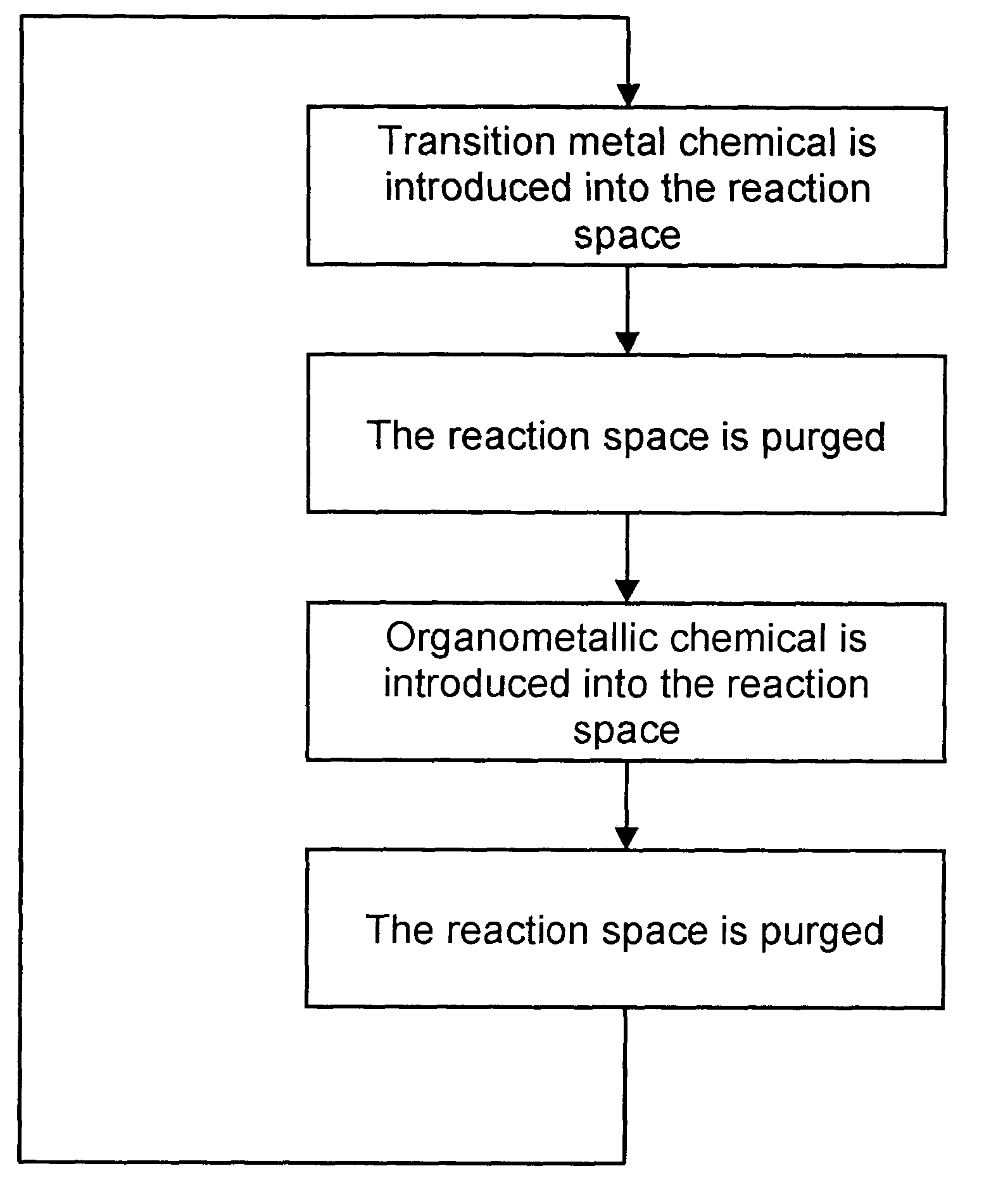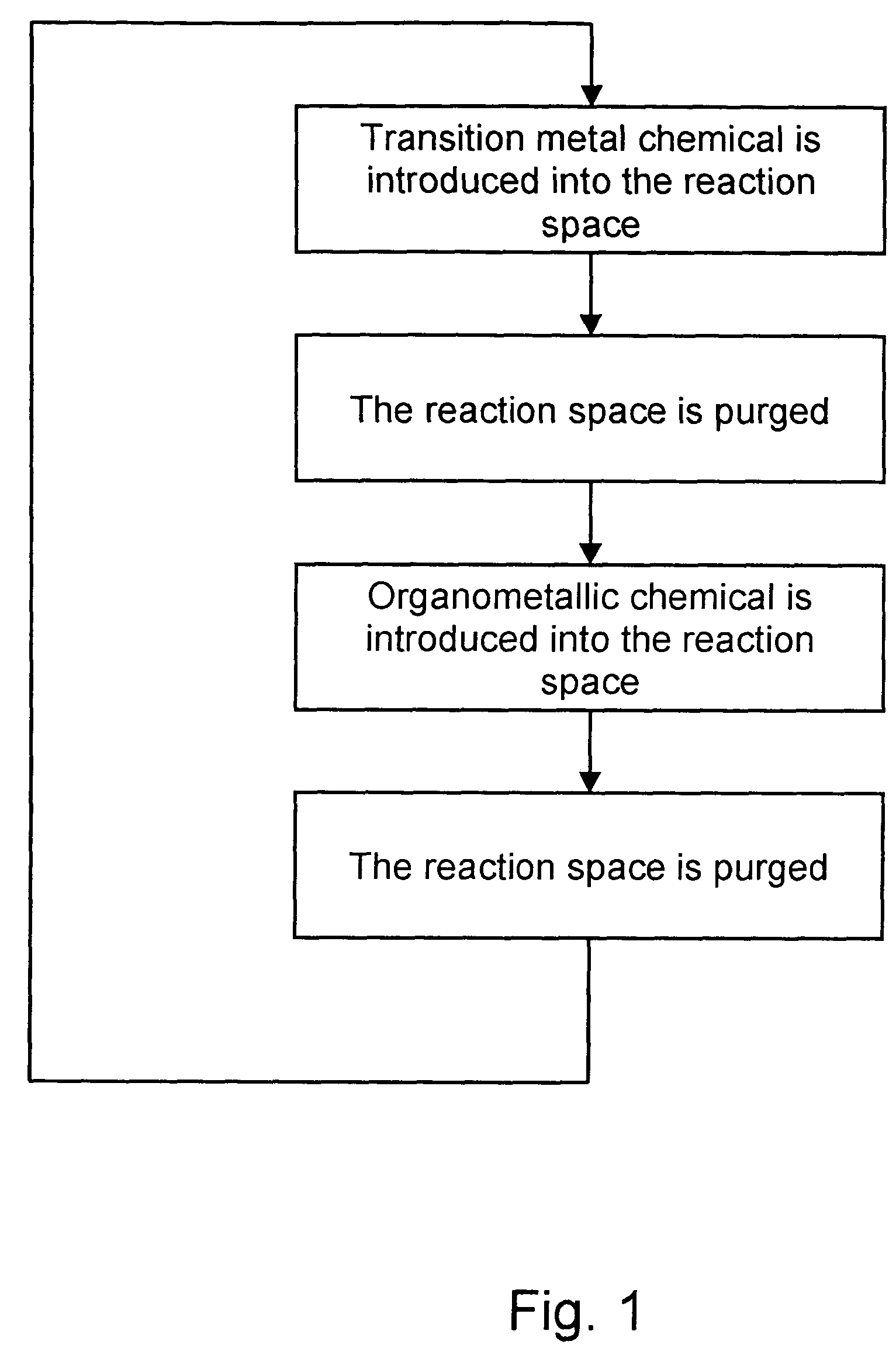Deposition of carbon- and transition metal-containing thin films
a technology of transition metals and thin films, applied in the field of carbon and transition metal-containing thin films, can solve the problems of inability to successfully use transition metal carbides, carbide films, and films likely to contain trace amounts of boron, silicon, or phosphorus contamination, and achieve excellent adhesion and step coverage properties, uniform thickness, and excellent adhesion
- Summary
- Abstract
- Description
- Claims
- Application Information
AI Technical Summary
Benefits of technology
Problems solved by technology
Method used
Image
Examples
example 1a
[0045]A 195 mm×265 mm×1 mm glass substrate and a 200 mm silicon wafer substrate were loaded into the reaction space of a flow-type ALD reactor. The glass substrate was placed on top of a planar substrate holder plate such that only one of the glass substrate surfaces was exposed to the gas flow. The silicon wafer substrate was installed horizontally but supported from the edges in order to keep both sides of the wafer exposed to the gas flow. After loading the substrates into the reactor, the reaction space was pumped down and purged with N2 gas (99.999% purity, AGA Oy). The N2 gas flow rate was adjusted to 3 standard liters per minute (slm) in order to maintain a pressure of about 1 mbar inside the reaction space. The heated reaction space was allowed to stabilize for 5 hours, during which the reaction space and the substrates reached a targeted process temperature of about 400° C.
example 1b
[0046]A 195 mm×265 mm×1 mm glass substrate and a 200 mm silicon wafer substrate were loaded into the reaction space of a flow-type ALD reactor. The glass substrate was placed on top of a planar substrate holder plate such that only one of the glass substrate surfaces was exposed to the gas flow. The silicon wafer substrate was installed horizontally but supported from the edges in order to keep both surfaces of the wafer exposed to the gas flow. After loading the substrates into the reactor, the reaction space was pumped down and purged with N2 gas (99.999% purity, AGA Oy). The N2 gas flow rate was adjusted to 3 standard liters per minute (slm) in order to maintain a pressure of about 1 mbar inside the reaction space. The heated reaction space was allowed to stabilize for 5 hours, during which the reaction space and the substrates reached a targeted process temperature of about 500° C.
[0047]Alternating pulses of titanium tetrachloride (TiCl4) (99.9% purity, Aldrich), the transition ...
example 2
[0054]A 195 mm×265 mm×1.1 mm glass substrate, a 4 inch silicon wafer substrate, and a 10 mm carbon wafer substrate were loaded into a reaction space of a flow-type ALD reactor. The glass substrate was positioned on top of a planar substrate holder plate in order to expose only one of the glass substrate surfaces to the gas flow. The silicon wafer substrate and the carbon wafer substrate were placed on the glass substrate in order to expose only one surface of each of the wafers to gas flow. After loading the substrates into the reactor, the reaction space was pumped down and purged with N2 gas (99.999% purity, AGA Oy). The N2 gas flow rate was adjusted to 3 slm in order to maintain a pressure of about 1 mbar inside the reaction space. The heated reaction space was allowed to stabilize for 3 hours, during which time the reaction space and substrates reached a temperature of about 525° C.
[0055]Alternating pulses of titanium tetrachloride (TiCl4) (99.9% purity, Aldrich), the transition...
PUM
| Property | Measurement | Unit |
|---|---|---|
| pressure | aaaaa | aaaaa |
| temperature | aaaaa | aaaaa |
| temperature | aaaaa | aaaaa |
Abstract
Description
Claims
Application Information
 Login to View More
Login to View More - R&D
- Intellectual Property
- Life Sciences
- Materials
- Tech Scout
- Unparalleled Data Quality
- Higher Quality Content
- 60% Fewer Hallucinations
Browse by: Latest US Patents, China's latest patents, Technical Efficacy Thesaurus, Application Domain, Technology Topic, Popular Technical Reports.
© 2025 PatSnap. All rights reserved.Legal|Privacy policy|Modern Slavery Act Transparency Statement|Sitemap|About US| Contact US: help@patsnap.com



